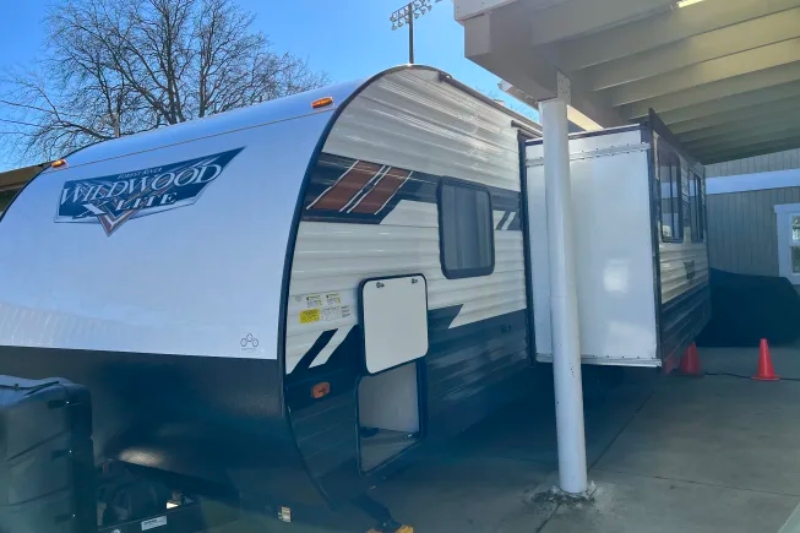Thanks for your support! If you make a purchase using our links in this article, we may make a commission. And, as an Amazon Associate, I earn from qualifying purchases. See the full disclosure here.
When it’s time to wrap up the RV season, should you store an RV with the slides in, or out? There’s plenty of debate on this subject, but the best practice is to store your RV with the slides in, not out.
Storing your RV with the slides in reduces the chance of damaging the frame of your RV or trailer. Keeping the slide box in travel mode avoids causing problems like leaky seals or unwanted visitors. Here’s what you need to know about storing your RV with slide-outs.
Store Your RV With the Slide Outs In
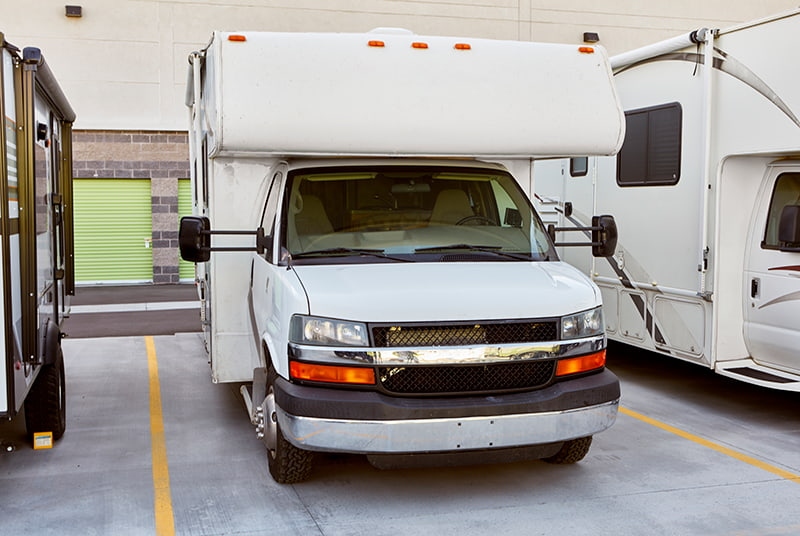
Slides on your RV are made in a way that makes them really effective when extended for short periods of time. But, when left extended over a longer period of time, your slide-outs can actually be harmful to your RV. This is why it’s important to store your RV with the slides in.
Now, it’s important to mention that you don’t need to put your slides in every time you leave your RV, or when it’s not being used for a couple of weeks. It’s when your RV is stored for multiple months longer that leaving the slides out can become a problem.
There are plenty of good reasons to store your RV with the slides in, but we think that the most important is that you don’t want to damage the integrity of your RV’s frame.
Your RV and its slide-outs are an engineering marvel, but they aren’t made to be extended for months at a time. Leaving your slide-outs extended when your RV is in storage can cause the slide box to sag, seals to fail, and pests to move into your RV.
It may seem tempting to just leave your slides out. So, before you make this RV storage decision, remember how much you love to be on the road, and how much you dislike having your RV in for repairs.
5 Problems If You Store Your RV With the Slides Out
We mentioned a few reasons why you shouldn’t store your RV with the slides out, but there are many reasons why storing your RV with the slides out is not a great idea. Here are 5 problems you may encounter if you store your RV with the slides out.
1. The Slide Out Box Sags From Frame Damage
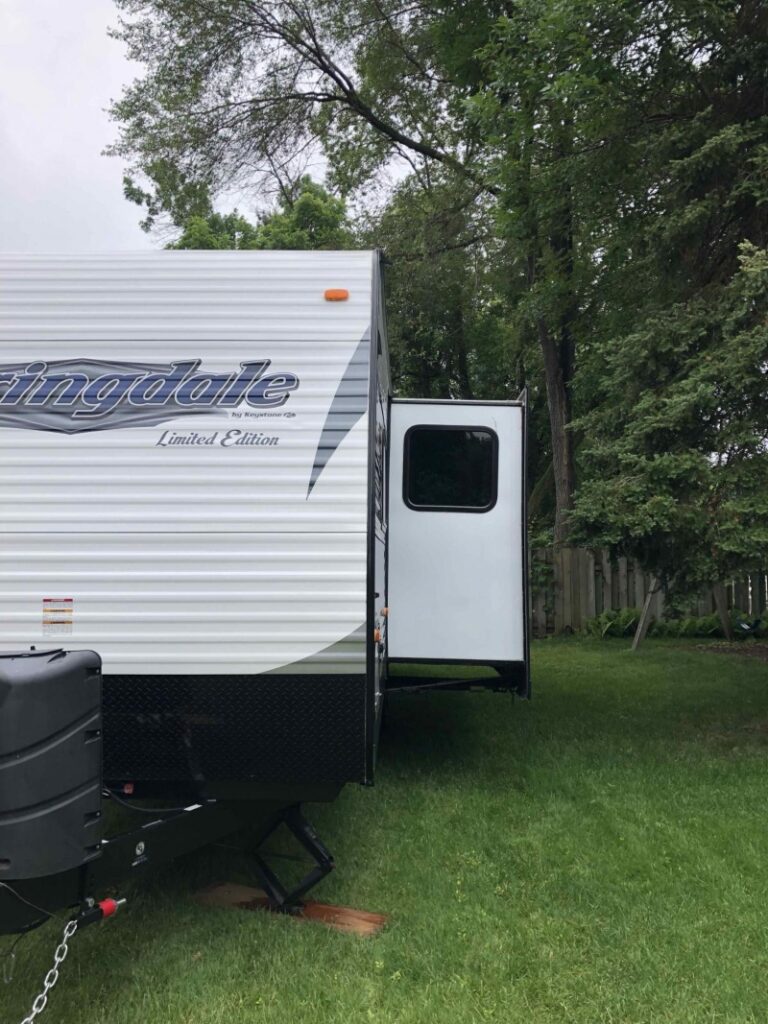
RV slide-outs are designed to support their weight and the added weight of people. However, they are usually not designed to support their own weight for an extended period of time.
When your RV slide is left out during storage, the weight of the slide plus gravity pulls down on the slide. This can warp the frame of the slide, causing the slide-out box to sag.
When your slide-out sags, it may be difficult to slide it in, and you risk damaging the wall of your RV or the mechanism that moves the slide in and out.
2. The Slide Out Mechanisms May Deteriorate
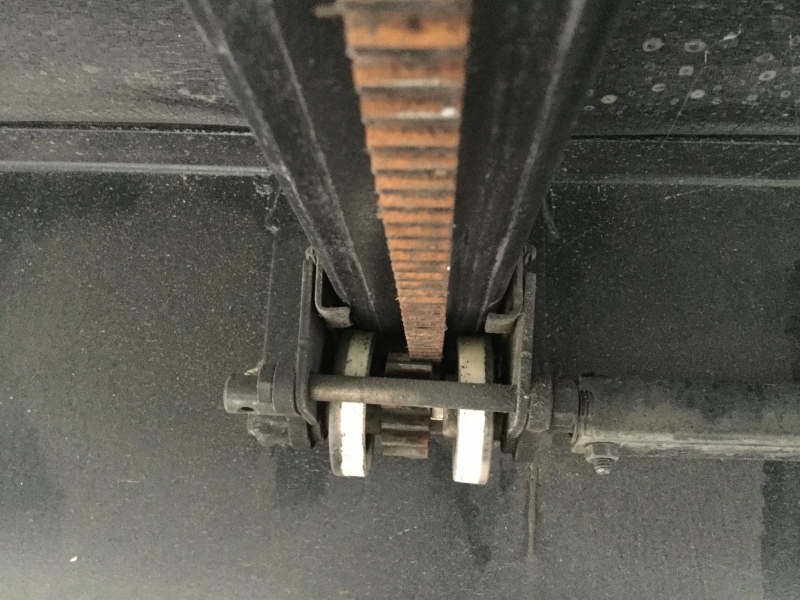
The slide out of your RV functions in one of two ways: using a small motor that moves the slide out on a set of tracks that are on the edges of the slide; or the motor moves a piston that’s attached to a frame on the underside of the slide.
In both cases, parts of the slide’s mechanism are exposed when the slide is out. When you store your RV with the slides out these parts are exposed to the elements.
Things like rain or snow, UV rays, and hot or cold temperatures can cause rusting or cracking of the parts of the slide mechanism. Over time, this deterioration can cause the slide mechanism to fail.
3. Weatherstripping Will Dry Out
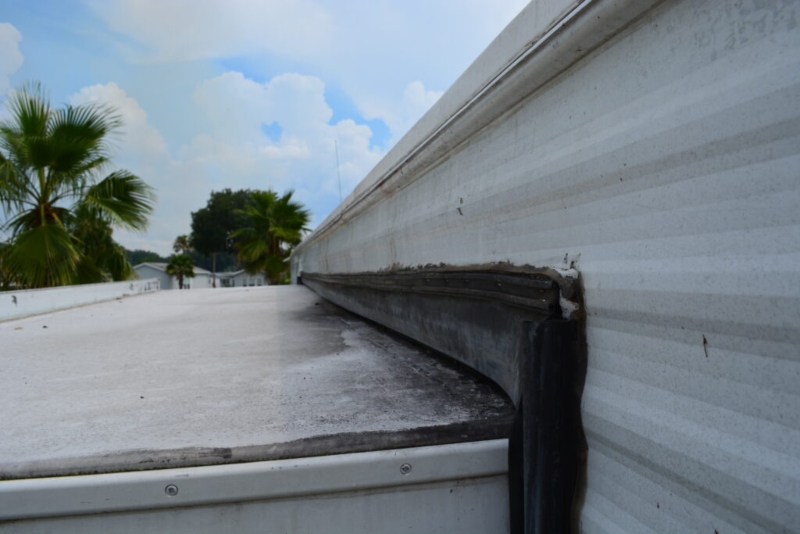
If you’ve ever had a leak in your RV, you know just how important weatherstripping is for keeping your traveling home dry and free of drafts. Your RV slides have weatherstripping around the slide box, which creates a seal between the slide and the RV.
When you store your RV with the slides out, the weatherstripping is exposed to the elements and UV rays. After prolonged exposure, it can eventually dry out and crack.
When the weatherstripping cracks or falls apart, it’ll allow weather and debris in your RV through the space between the slide and the RV wall.
4. Pests May Invade Your RV

When you’re out traveling, it’s fun to see wildlife and experience a bit of nature. But nature and wildlife belong in nature, not in your RV.
There’s a bit of debate about whether leaving the slides out when your RV is in storage actually increases the likelihood that you’ll end up with critters in your RV. And there’s no concrete evidence that it does (or doesn’t).
However, we do know that mice, spiders, snakes and other creatures looking for a dry and cozy place to spend the winter are very good at finding their way through even the tiniest of gaps.
Gravity and time will cause your RV to settle or change position ever so slightly, and this can open up gaps in the weatherstripping or small gaps at joints in the slide. These gaps can be tempting for rodents and insects.
Keeping your RV slides in while in storage reduces the risk that your RV becomes home to an unwanted animal.
5. Moisture Can Seep Inside

Because the tops of your slide are flat, they don’t shed rain or snow like the top of your RV which has a bit of a curved surface. The flat surface of the RV slide is a perfect place for water and snow to sit.
When your RV slides are exposed to moisture for an extended time the risk for damage increases. Water or snow sitting on the slide can damage the slide roof and cause leaks into your RV.
Water leaks in your RV slide can cause structural damage and can also cause damage to furnishings or stored items in the RV slide.
To protect your RV and your belongings from unwanted moisture, it’s best to store your RV with the slides in.
How Much Weight Can a Slide Out Hold?

The slides on your RV are designed to hold the weight of the slide, mechanisms, furnishings, and of course, people. Not all slides are designed to hold the same amount of weight, and the location of the slide can make a big difference in how much weight it’s designed to support.
In general, most RV slide-outs are designed to support between 600 and 1,500 pounds. Some larger RVs or RVs with high-end components may be able to hold more weight.
It’s important that you consult your RV owner’s manual for the exact weight limits of the slide-outs on your particular RV. The owner’s manual will also provide you guidance on storing items in the slide-outs of your RV.
Too much weight on your RV slide-out can impact the function of the slide mechanism resulting in causing damage to the slide box. If you store your RV with the slides out, and it’s holding too much weight, this can cause substantial damage to the slide and your RV’s frame.
6 Maintenance Tips Before Storing Your RV With Slide Outs
When you are getting your RV ready for storage there are some maintenance tasks that you should perform to protect your RV and the slides on your RV.
Here are 6 maintenance tips you should follow before storing your RV with slide-outs. If you are a first-time RV owner, check out this site for more tips on storing your RV. You can also use RVBlogger’s 115-point maintenance checklist that covers these and other slide-out inspection points.
1. Lubricate the Weatherstripping
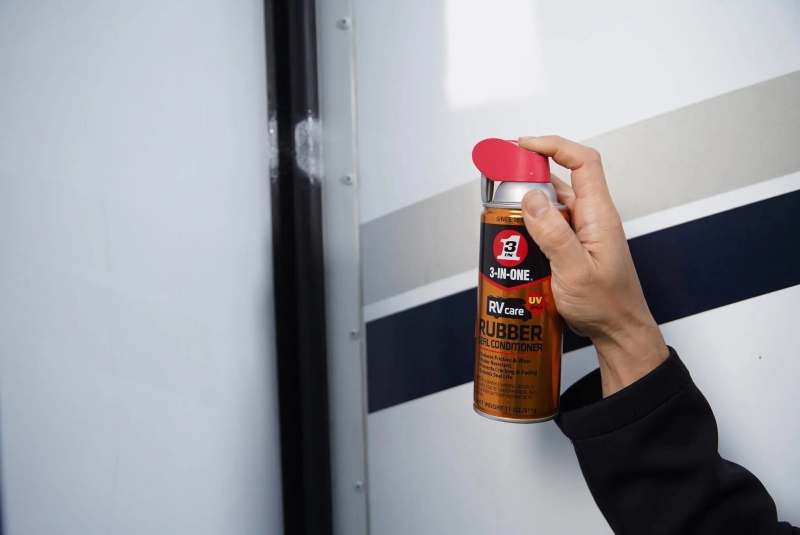
Your weatherstripping can dry out and become brittle over time, especially if you live in or store your RV in an arid climate. spraying lubricant on the weatherstripping on your RV’s slide outs will protect them from drying out.
Lubricants can also keep weather stripping from sticking to the slide-out. If the weatherstripping sticks to the slide-out or the RV wall, it can tear when you open the slide for the first time.
In both cases, damage to the weatherstripping from either drying out or sticking can cause leaks in your RV slide out.
2. Spray Your Slide Out Tracks
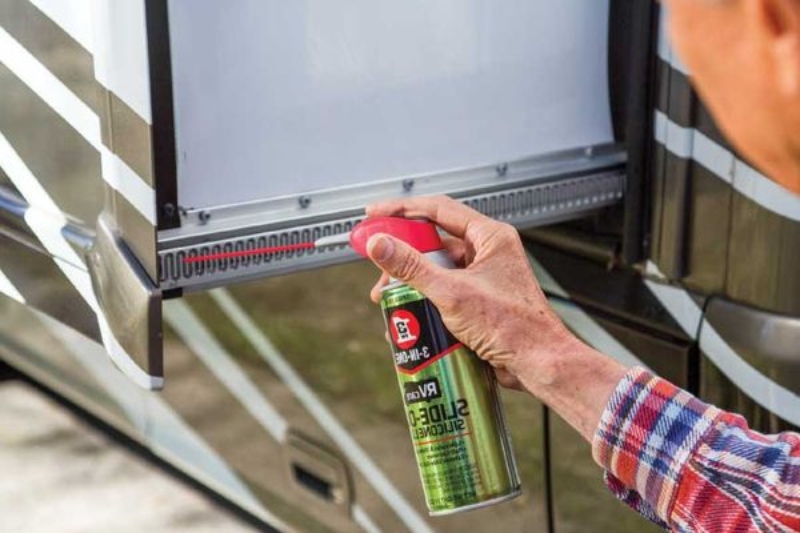
A bit of WD-40 or a silicone lubricant in the slide-out tracks will keep them from running rough.
Before you add a lubricant to the slide-out tracks, make sure that they are free of dirt and debris. Use a can of compressed air or an air compressor to gently blow any dust, dirt, or debris from the tracks.
Lubricating the slide-out tracks without cleaning them first, causes dirt or debris to stick to the slide-out tracks. As a result, this can cause the slide mechanism to struggle or even fail.
3. Check the Top of the Slide Box for Debris
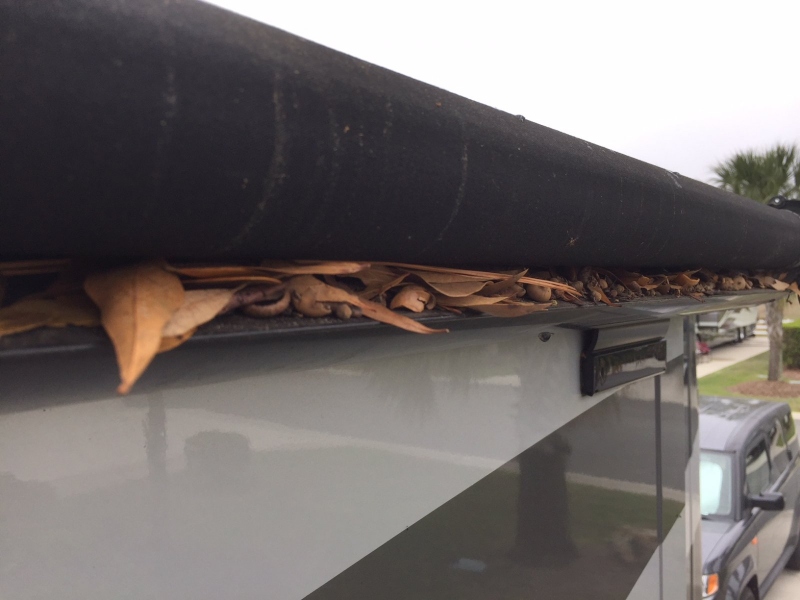
This is a good habit to get into every time you close the slide-outs but is even more important when you are getting ready to store your RV.
Debris that builds up on the top of your RV slide-out can cause the slide to not close completely, and damage the weatherstripping, or slide roof. If you see that your slide-out has debris on the roof of the slide box, use a broom or air compressor to remove it from the slide.
4. Inspect the Slide Awning for Damage
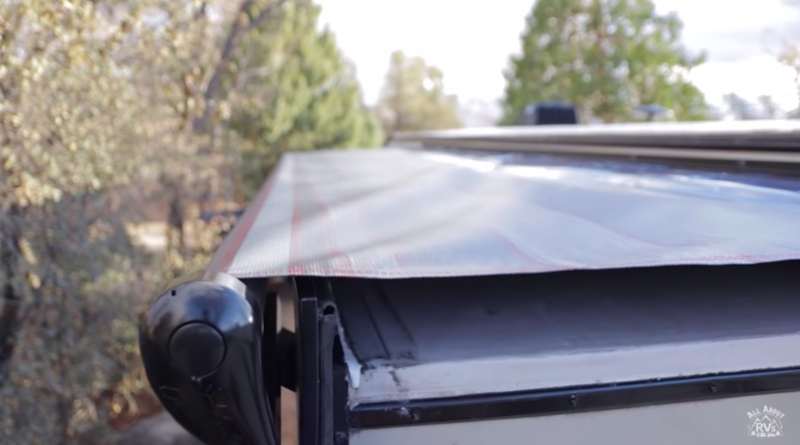
If your RV’s slide out has an awning, make sure that you open it completely and check for any damage. Even small holes, tears, or weak spots can get worse while your RV sits in storage.
It’s especially important to check the awning supports and locks for dents, bends, and damage. These parts if damaged can pull on the outside of the slide out and cause damage to the RV siding.
5. Ensure the Slide Out is Evenly On Track
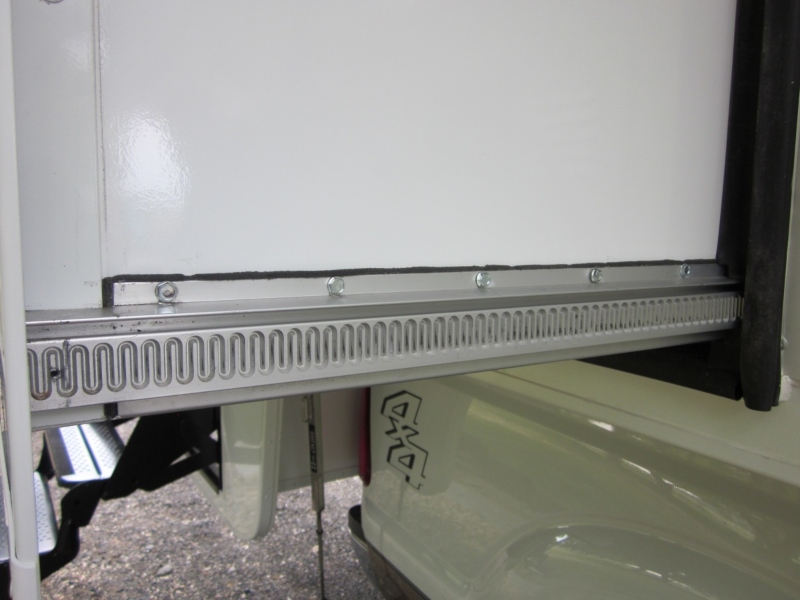
Even if you are always very careful about returning your slide-outs into your RV, the slide box can come off its track, and become crooked. If your slide-out is crooked it won’t shut properly.
If you notice that your slide-out is not straight on its tracks, you’ll need to adjust the slide mechanism. The process for this is different depending on the type of mechanism, so refer to your owner’s manual before making adjustments.
6. Listen for Irregular Sounds From the Slide Motors
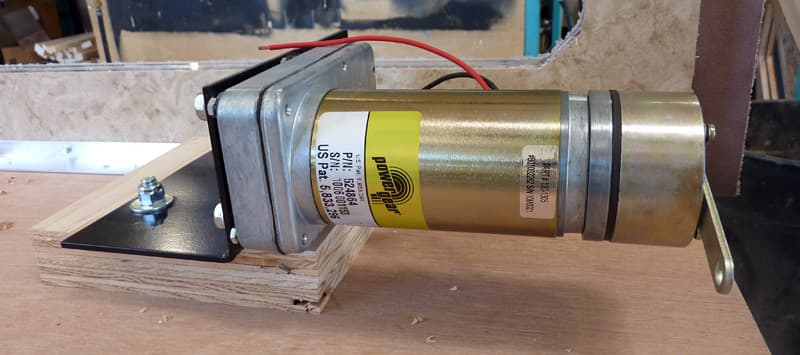
Strange noises can be a good indication that something isn’t working correctly with your RV slide-outs mechanism. If you’re getting ready to store your RV and you notice strange noises when you close the slide, stop and check for debris, loose parts, or misaligned tracks.
Make sure you resolve any issues you find before you finish closing the slide out and storing your RV for the season.
Do You Level Your RV With the Slides Out?
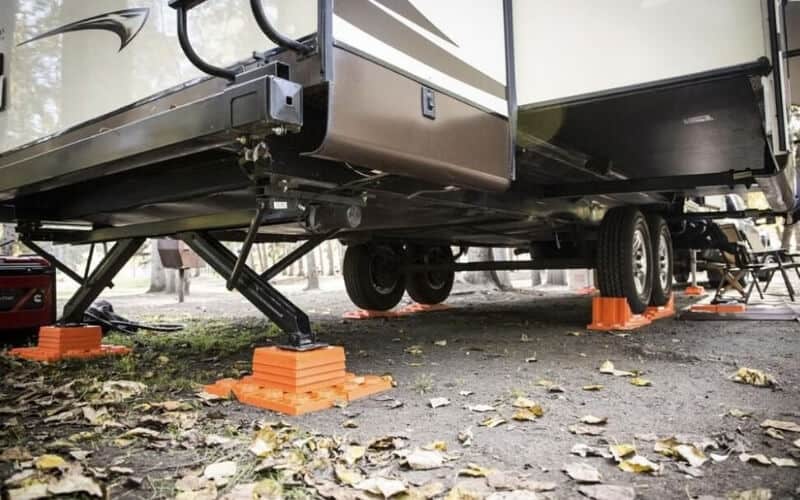
When you’re leveling your RV, you want to make sure that your RV slides are not out. This is particularly important if your RV or trailer has hydraulic leveling jacks.
The slide-outs on your RV can change the weight distribution of the RV if they are out when you are leveling your coach. This can cause strain on your leveling system and add stress to the slide-out frame.
Check your owner’s manual for the proper process for leveling your RV, including the correct time to open your slides during the leveling process. While most RVs shouldn’t be leveled with the slides out, there are always exceptions to every rule.
Final Thoughts on Storing Your RV With the Slides In or Out
When it comes to the question of whether should you store an RV with the slides in or out, the best rule of thumb is to put the slides in during storage. Storing your RV with the slides in protects your RV and its slides from weather damage, pests, and gravity.
Properly storing your RV with slide-outs reduces wear on your RV and will keep you traveling with minimal downtime for repairs and unexpected difficulties.
1. 5 Best RV Slide Out Mechanisms Today
2. Do RVs Really Need Slide Out Stabilizers?
3. Indoor Versus Outdoor RV Storage Facilities
4. Do You Have to Winterize an RV or Camper?
5. 6 Best Portable RV Garage And Shelter Kits
About the Author
Jason Gass – Author and Part Time RVer
Jason Gass is a full-time freelance writer and part-time RVer whose goal is to share great stories around a campfire with good friends.
When he’s not working, he spends most of his time camping, searching for the best breweries, and road-tripping in his teardrop trailer with his wife, daughter, and two dogs.


